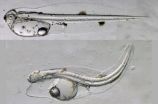(Press-News.org) Crude oil from the 2010 Deepwater Horizon disaster causes severe defects in the developing hearts of bluefin and yellowfin tunas, according to a new study by a team of NOAA and academic scientists.
The findings, published in the Proceedings of the National Academy of Sciences on the 25th anniversary of the Exxon Valdez oil spill, show how the largest marine oil spill in United States history may have affected tunas and other species that spawned in oiled offshore habitats in the northern Gulf of Mexico.
Atlantic bluefin tuna, yellowfin tuna, and other large predatory fish spawn in the northern Gulf during the spring and summer months, a time that coincided with the Deepwater Horizon spill in 2010. These fish produce buoyant embryos that float near the ocean surface, potentially in harm's way as crude oil from the damaged wellhead rose from the seafloor to form large surface slicks.
The new study shows that crude oil exposures adversely affect heart development in the two species of tuna and an amberjack species by slowing the heartbeat or causing an uncoordinated rhythm, which can ultimately lead to heart failure.
"We know from the 1989 Exxon Valdez spill in Prince William Sound that recently spawned fish are especially vulnerable to crude oil toxicity," said Nat Scholz, Ph.D., leader of the ecotoxicology program at NOAA's Northwest Fisheries Science Center in Seattle. "That spill taught us to pay close attention to the formation and function of the heart."
"The timing and location of the spill raised immediate concerns for bluefin tuna," said Barbara Block, Ph.D., a study coauthor and professor of biology at Stanford University. "This spill occurred in prime bluefin spawning habitats, and the new evidence indicates a compromising effect of oil on the physiology and morphology of bluefin embryos and larvae."
Recent studies are increasingly painting a more detailed picture of how oil-derived polycyclic aromatic hydrocarbons (PAHs) act on the heart. Earlier this year, the Stanford-NOAA team showed in a related paper published in Science (Brette et al. 343: 772) that Deepwater Horizon crude oil samples block excitation-contraction coupling--vital processes for normal beat-to-beat contraction and pacing of the heart--in individual heart muscle cells isolated from juvenile bluefin and yellowfin tuna.
"We now have a better understanding why crude oil is toxic, and it doesn't bode well for bluefin or yellowfin embryos floating in oiled habitats." said Block. "At the level of a single heart muscle cell, we've found that petroleum acts like a pharmacological drug by blocking key processes that are critical for cardiac cell excitability."
This mechanism explains why the team observed a range of cardiac effects in the developing hearts of intact embryos in the present study. "We directly monitored the beating hearts of living fish embryos exposed to crude oil," said Dr. John Incardona, NOAA research toxicologist and the study's lead author. "The tiny offspring of tunas and other Gulf species are translucent, and we can use digital microscopy to watch the heart develop."
The major difficulty facing the researchers was access to live animals. Tunas are difficult to raise in captivity and few facilities exist worldwide with spawning fish. In the open ocean, fragile fish embryos and larvae are mixed with many other types of plankton, and they usually don't survive the rough conditions in a net towed near the surface. This made it close to impossible to assess developmental cardiotoxicity in samples collected near the Deepwater Horizon surface oil slicks.
To work around this challenge, the international team brought the oil to the fish. Samples of crude oil were collected from the damaged riser pipe and surface skimmers. The samples were then transported to the only land-based hatcheries in the world capable of spawning tunas in captivity.
This approach allowed the scientists to design environmentally relevant crude oil exposures for bluefin tuna and yellowfin tuna at marine research facilities in Australia and Panama, respectively. Luke Gardner, an Australian native post-doctoral associate from Stanford University and co-author on the PNAS paper, was vital in helping the team investigate the bluefin.
"It is challenging to maintain bluefin in culture and we were privileged to have successfully tested the crude oil in Australian facilities, the only on-land hatchery that has bluefin tuna in culture. This gave us access to tuna embryos and allowed us to study the developmental toxicity of oil," said Gardner. The pioneering effort to develop new testing methods was also led by Martin Grosell, Ph.D., at the University of Miami.
The new research adds to a growing list of fish that are affected by crude oil. "This fits the pattern," said Incardona. "The tunas and the amberjack exposed to Deepwater Horizon crude oil were impacted in much the same way that herring were deformed by the Alaska North Slope crude oil spilled in Prince William Sound during the Exxon Valdez accident."
Crude oil is a complex mixture of chemicals, some of which are known to be toxic to marine animals. Past research has focused in particular on PAHs, which can also be found in coal tar, creosote, air pollution and stormwater runoff from land. In the aftermath of an oil spill, PAHs can persist for many years in marine habitats and cause a variety of adverse environmental effects.
Developmental abnormalities were evident in bluefin and yellowfin tunas at very low concentrations, in the range of approximately one to 15 parts per billion total PAHs. These levels are below the measured PAH concentrations in many samples collected from the upper water column of the northern Gulf during the active Deepwater Horizon spill phase.
Severely affected fish with heart failure and deformed jaws are likely to have died soon after hatching. However, the NOAA team has shown in previous work that fish surviving transient crude oil exposures with only mild effects on the still-forming heart have permanent changes in heart shape that reduce swimming performance later in life.
"This creates a potential for delayed mortality," said Incardona. "Swimming is everything for these species."
The nature of the injury was very similar for all three pelagic predators, and similar also to the response of other marine fish previously exposed to crude oil from other geologic sources. Given this consistency, the authors suggest there may have been cardiac-related impacts on swordfish, marlin, mackerel, and other Gulf species. "If they spawned in proximity to oil, we'd expect these types of effects," said Incardona.
INFORMATION:
The research was funded by NOAA as part of the on-going Natural Resource Damage Assessment for the Gulf ecosystem following the April 20, 2010 Deepwater Horizon oil spill. Contributing to the findings in addition to NOAA and Stanford University were researchers from the University of Miami's Rosenstiel School of Marine and Atmospheric Sciences and the University of the Sunshine Coast in Queensland, Australia.
NOAA led study: Crude oil causes developmental abnormalities in large marine fish
Study shows Deepwater Horizon oil disrupts heart development in tunas
2014-03-25
ELSE PRESS RELEASES FROM THIS DATE:
For neurons in the brain, identity can be used to predict location
2014-03-25
Cold Spring Harbor, NY – Throughout the world, there are many different types of people, and their identity can tell a lot about where they live. The type of job they work, the kind of car they drive, and the foods they eat can all be used to predict the country, the state, or maybe even the city a person lives in.
The brain is no different. There are many types of neurons, defined largely by the patterns of genes they use, and they "live" in numerous distinct brain regions. But researchers do not yet have a comprehensive understanding of these neuronal types and how ...
Scientists find a molecular clue to the complex mystery of auxin signaling in plants
2014-03-25
Wikipedia lists 65 adjectives that botanists use to describe the shapes of plant leaves. In English (rather than Latin) they mean the leaf is lance-shaped, spear-shaped, kidney-shaped, diamond shaped, arrow-head-shaped, egg-shaped, circular, spoon-shaped , heart-shaped, tear-drop-shaped or sickle-shaped — among other possibilities.
How does the plant "know" how to make these shapes? The answer is by controlling the distribution of a plant hormone called auxin, which determines the rate at which plant cells divide and lengthen.
But how can one molecule make so many ...
Innovative technique provides inexpensive, rapid and detailed analysis of proteins
2014-03-25
Proteins are vital participants in virtually all life processes, including growth, repair and signaling in cells; catalysis of chemical reactions and defense against infection. For these reasons, proteins can provide critical signposts of health and disease, provided they can be identified and assessed in a clinical setting.
Accurately characterizing proteins for diagnostic and therapeutic purposes has been an enormous challenge for the medical community. At the Biodesign Institute's Molecular Biomarkers Laboratory at Arizona State University, research focuses on the ...
Researchers take mathematical route to fighting viruses
2014-03-25
Mathematicians at the University of York have joined forces with experimentalists at the University of Leeds to take an important step in discovering how viruses make new copies of themselves during an infection.
The researchers have constructed a mathematical model that provides important new insights about the molecular mechanisms behind virus assembly which helps to explain the efficiency of their operation.
The discovery opens up new possibilities for the development of anti-viral therapies and could help in the treatment of a range of diseases from HIV and Hepatitis ...
A new concept for manufacturing wrinkling patterns on hard nano-film/soft-matter substrate
2014-03-25
Wrinkling is a common phenomenon for thin stiff film adhered on soft substrate. Various wrinkling phenomenon has been reported previously. Wu Dan, Yin Yajun, Xie Huimin,et al from Tsinghua University proposed a new method to control wrinkling and buckling of thin stiff film on soft substrate. It is found that the curve pattern on the soft substrate has obvious influence on the wrinkling distribution of the thin film/soft substrate. Their work, entitled "Controlling the surface buckling wrinkles by patterning the material system of hard-nano-film/soft-matter-substrate", ...
Psychiatric complications in women with PCOS often linked to menstrual irregularity
2014-03-25
(NEW YORK, NY, March 24, 2014) – Polycystic ovary syndrome (PCOS), a hormone imbalance that causes infertility, obesity, and excessive facial hair in women, can also lead to severe mental health issues including anxiety, depression, and eating disorders. A study supervised by Columbia University School of Nursing professor Nancy Reame, MSN, PhD, FAAN, and published in the Journal of Behavioral Health Services & Research, identifies the PCOS complications that may be most responsible for psychiatric problems. While weight gain and unwanted body hair can be distressing, irregular ...
Shorter sleepers are over-eaters
2014-03-25
Young children who sleep less eat more, which can lead to obesity and related health problems later in life, reports a new study by UCL researchers.
The study found that 16 month-old children who slept for less than 10 hours each day consumed on average 105kcal more per day than children who slept for more than 13 hours. This is an increase of around 10% from 982kcal to 1087kcal.
Associations between eating, weight and sleep have been reported previously in older children and adults, but the study, published in the International Journal of Obesity, is the first to directly ...
Instant immune booster dramatically improves outcome of bacterial meningitis and pneumonia
2014-03-25
AUDIO:
This is a podcast interview with Professor Schwaeble.
Click here for more information.
"I am really excited about this landmark discovery. We demonstrate that boosting the innate immune system can have a significant impact on the body's ability to defend itself against life-threatening infections" - Professor Wilhelm Schwaeble from the University of Leicester's Department of Infection, Immunity and Inflammation
IMAGES AND A PODCAST INTERVIEW WITH PROFESSOR SCHWAEBLE ...
Protein plays key role in infection by oral pathogen
2014-03-25
CAMBRIDGE, Mass., March 24 — Scientists at Forsyth, along with a colleague from Northwestern University, have discovered that the protein, Transgultaminase 2 (TG2), is a key component in the process of gum disease. TG2 is widely distributed inside and outside of human cells. The scientists found that blocking some associations of TG2 prevents the bacteria Porphyromonas gingivalis (PG) from adhering to cells. This insight may one day help lead to novel therapies to prevent gum disease caused by PG.
Periodontal, or gum, disease is one of the most common infectious diseases. ...
Studying crops, from outer space
2014-03-25
Washington, D.C.— Plants convert energy from sunlight into chemical energy during a process called photosynthesis. This energy is passed on to humans and animals that eat the plants, and thus photosynthesis is the primary source of energy for all life on Earth. But the photosynthetic activity of various regions is changing due to human interaction with the environment, including climate change, which makes large-scale studies of photosynthetic activity of interest. New research from a team including Carnegie's Joe Berry reveals a fundamentally new approach for measuring ...
LAST 30 PRESS RELEASES:
Making lighter work of calculating fluid and heat flow
Normalizing blood sugar can halve heart attack risk
Lowering blood sugar cuts heart attack risk in people with prediabetes
Study links genetic variants to risk of blinding eye disease in premature infants
Non-opioid ‘pain sponge’ therapy halts cartilage degeneration and relieves chronic pain
AI can pick up cultural values by mimicking how kids learn
China’s ecological redlines offer fast track to 30 x 30 global conservation goal
Invisible indoor threats: emerging household contaminants and their growing risks to human health
Adding antibody treatment to chemo boosts outcomes for children with rare cancer
Germline pathogenic variants among women without a history of breast cancer
Tanning beds triple melanoma risk, potentially causing broad DNA damage
Unique bond identified as key to viral infection speed
Indoor tanning makes youthful skin much older on a genetic level
Mouse model sheds new light on the causes and potential solutions to human GI problems linked to muscular dystrophy
The Journal of Nuclear Medicine ahead-of-print tip sheet: December 12, 2025
Smarter tools for peering into the microscopic world
Applications open for funding to conduct research in the Kinsey Institute archives
Global measure underestimates the severity of food insecurity
Child survivors of critical illness are missing out on timely follow up care
Risk-based vs annual breast cancer screening / the WISDOM randomized clinical trial
University of Toronto launches Electric Vehicle Innovation Ontario to accelerate advanced EV technologies and build Canada’s innovation advantage
Early relapse predicts poor outcomes in aggressive blood cancer
American College of Lifestyle Medicine applauds two CMS models aligned with lifestyle medicine practice and reimbursement
Clinical trial finds cannabis use not a barrier to quitting nicotine vaping
Supplemental nutrition assistance program policies and food insecurity
Switching immune cells to “night mode” could limit damage after a heart attack, study suggests
URI-based Global RIghts Project report spotlights continued troubling trends in worldwide inhumane treatment
Neutrophils are less aggressive at night, explaining why nighttime heart attacks cause less damage than daytime events
Menopausal hormone therapy may not pose breast cancer risk for women with BRCA mutations
Mobile health tool may improve quality of life for adolescent and young adult breast cancer survivors
[Press-News.org] NOAA led study: Crude oil causes developmental abnormalities in large marine fishStudy shows Deepwater Horizon oil disrupts heart development in tunas







